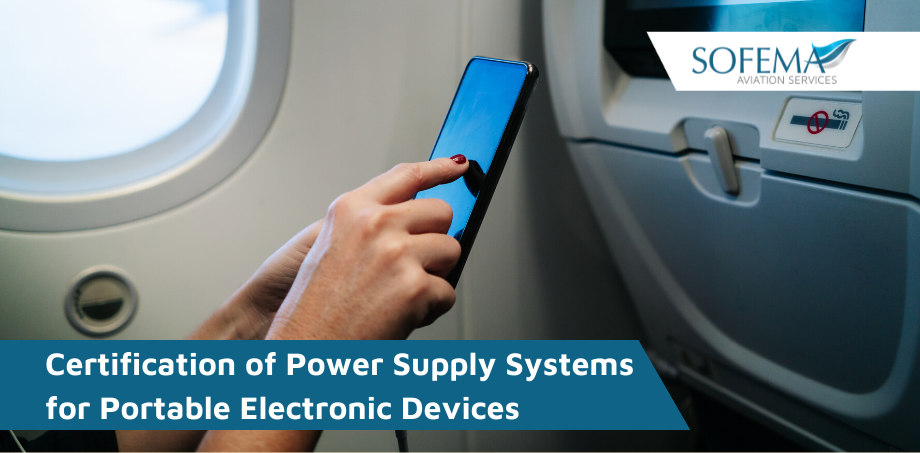Sofema Aviation Services (SAS) www.sassofia.com considers the current landscape with reference also to the EASA Certification Memorandum about Certification of Power Supply Systems for Portable Electronic Devices – EASA CM No.: EASA CM – ES – 001 Issue: 01; Issue Date: 07th of June 2012.
Introduction
It is increasingly becoming a passenger expectation to have access to In-seat power.
The typical delivery method of choice is via USB.
- Supporting both USB-A and USB-C devices.
- Delivering 2.1 amps per port. Tablets.
- Sealed units offer water-resistant protection against spills and surface cleaning solutions.
- USB outlets accounted for over 50% of total installations and by 2030 it is expected that this will increase to over 85%.
International Multiplug Solutions are often favoured in premium cabins. (AC+USB combo plugs in the same favoured over the standalone AC outlets).
Note – The move away from seatback IFE in favor of wireless IFE means in-seat power will increasingly be integrated into the seat architecture.
Categories of Portable Electronic Devices
PEDs are classified as either intentional or unintentional transmitters of electromagnetic signals. Those that intentionally transmit signals outside the device must do so to accomplish their functions. Examples of these PEDs are:
- Cell phones.
- Remote-control toys.
- Two-way pagers.
- Two-way radios.
Examples of non-intentional transmitters are:
- Audio players and recorders.
- Compact-disc players.
- Electronic games and toys.
- Laptop computers.
- Laser pointers.
- Handheld computers.
Historical Background Related to Portable Electronic Devices (PED)
Recommendations and Regulations regarding (Portable Electronic Devices) PED-related anomalies have been established by several agencies, including the U.S. Radio Technical Commission for Aeronautics (RTCA), the FAA, and the U.S. Federal Communications Commission (FCC), and Boeing.
FAR 91.19, now 91.21, states that the responsibility for ensuring that PEDs will not cause interference with airplane navigation or communication systems remained with the operator of the airplane.
RTCA document DO-199, “Potential Interference to Aircraft Electronic Equipment From Devices Carried Aboard,” lists the eight conditions that are required for an airplane antenna receiver system to experience interference from a PED.
RTCA concluded that the probability of a PED interfering with an airplane receiver system is very low. In the case of an ILS localizer antenna, the probability of PED interference was calculated as one in one million. Based on the total number of flights per year (determined in 1988), the expected ILS localizer receiver disruption is once in any two-year period.
USB / Power Supply Engineering Requirements
The typical High Power USB In-Seat Power System utilizes a small power supply installed under each seat group.
- A USB Power Supply (USBPS) is typically installed at each seat group and provides up to four outputs to power the High-Power USB Outlet Units.
- The outlet units, convert the power from the USBPS to USB power providing up to 10.5W of power at each port.
- Outlet units also drive the optional In-Use Light to provide system fault status as well as an in-use indication.
- In larger installations where more control options are needed an Advanced Master Control Unit (AMCU) can be used.
Summary of EASA Requirements
- The standards clearly establish that the operation of any one unit or system of units of the PSS for PED must not adversely affect the operation of other electrical units or systems essential to safe aeroplane operation, nor create a hazard that would endanger the occupants.
- The PSS for PED should be designed to provide circuit protection against system overloads, smoke, and fire hazards resulting from intentional or unintentional systems shorts, faults, etc. These types of faults may be caused by spilled liquids or the insertion of conductive objects into the outlets.
- System Status Indication (Ref. CS 25.1301, CS 25.1322) – A means of indication should be provided to enable the cabin crew to identify which outlets are in use, except for USB outlets.
- Radiated and Conducted Emissions (Ref. CS 25.1353(a), CS 25.1431(d)) – The levels of conducted and radiated interference generated by the PSS for PED equipment via power supply feeders or other system components should not cause unacceptable degradation of performance of other aeroplane systems.
- Overheat Protection (Ref. CS 25.601, CS 25.1309) – The system components should include overheat protection.
- Flammability Requirements (Ref. CS 25.869) – All components associated with the PSS for PED should meet the applicable flammability requirements.
- Power limitation (Ref. CS 25.1301, CS 25.1360(a)) – The intended function of the PSS for PED is to supply the power needed to enable the PED to operate while connected to the power supply outlet. As such, the PSS for PED should not supply more power than the normally expected uses would demand. Limiting the power available at the outlets prevents the use of these outlets for purposes outside of the intended function.
- Maximum power available at PSS for PED outlets should be limited to 200 watts.
- Safety Assessment (Ref. CS 25.1309, CS 25.1709) – Appropriate qualitative and/or quantitative failure analyses of each installed power supply system for PED should be conducted to demonstrate compliance with CS 25.1309(b) and CS 25.1709.
- Installation of PSS for PED (Ref. Requirements relative to EWIS contained in CS-25 Subpart H).
- Cabin Decompression (Ref. CS 25.1309) – To remove power from all components containing high voltage circuits (EUROCAE ED- 14/RTCA DO-160).
- Additional Criteria for Installation of PSS for PED power outlets in areas where sources of water are present.
Next Steps
Follow this link to our Library to find & Download related documents for Free.
Sofema Aviation Services offers the following regulatory training: EASA CS 25 Compliant Cabin Certification & Mods Training Program – 5 Days
Please see the website or email team@sassofia.com for additional information.
Tags:
EASA CM, PSS, RTCA document DO-199, Federal Communications Commission, FCC, PED, usb, In-seat power, EASA CM - ES – 001, Aircraft, EASA Certification Memorandum, Portable Electronic Device, IFE, RTCA, Radio Technical Commission for Aeronautics (RTCA), Boeing, FAA, EASA





